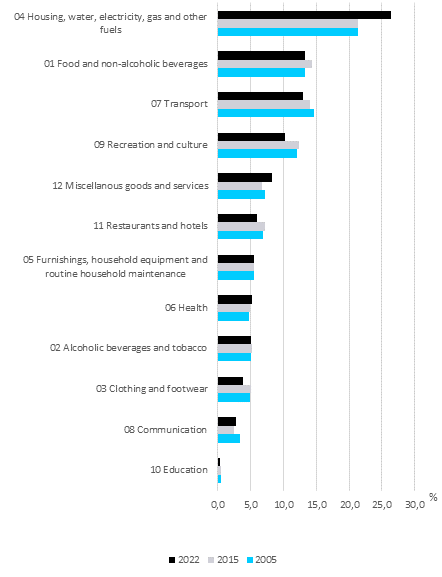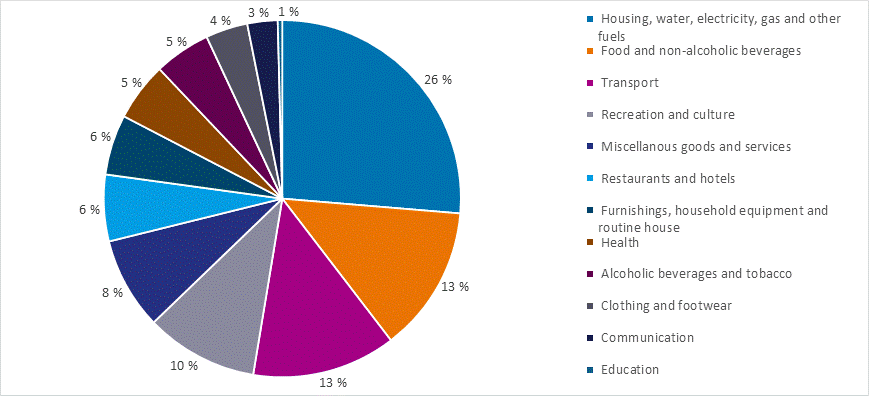Total consumption has risen by over eight per cent in Consumer Price Index weight structure from last year
Data collection
Due to the prolonged corona pandemic, the collection of prices for the Consumer Price Index in different areas of Finland is still varyingly challenging. For this reason, the focus of the price collection has gradually been shifted from shop visits to Internet price collection. The change in the price collection method describes the present situation, because, correspondingly, consumers' purchases have increasingly moved to online commerce. The price collection is also carried out centrally at Statistics Finland, where the data sources are other statistics, the Internet and mass data.
Commodity basket
The calculation of the Consumer Price Index is based on a commodity basket that is updated annually along with changes taking place in consumption. New commodities are added to the commodity basket if their annual consumption value is at least one per mil of total consumption. Correspondingly, commodities whose value share has fallen under one per mil of total consumption are removed from the commodity basket. With the help of the annually updated commodity basket, the inclusion of representative products and services in the index is ensured.
At the beginning of 2022, only top-fermented beer (e.g. ale, wheat beer, porter, stout) was added to the commodity basket. 02.1.3.2.1 Other medium strong beer, a new commodity group, was formed for this purpose. Under this new commodity group are two commodities, Other strong beer and Other medium beer.
Due to low consumption, the following commodities were removed from the commodity basket of 2022:
-
Top, baby
-
Contact lenses
-
Digital camera
-
Children’s and youth’s book
-
Package domestic holidays
-
Suitcase
Weight structure
According to the Regulation, the weight structure of the Consumer Price Index 2022 is based on national accounts calculations on private consumption expenditure. We now continue with the method adopted last year, in which the consumption expenditure of commodity groups on the 4-digit level is taken from private consumption expenditure for 2021, which is calculated quarterly in national accounts.
In the weight structure of the Consumer Price Index, the total value of private consumption was nearly EUR 114 billion in 2021, while it was approximately EUR 105 billion in 2020. Private consumption expenditure has thus risen by over eight per cent.
Private consumption expenditure in national accounts is divided by purpose of use category, of which 4-digit and 5-digit purpose of use categories are taken into account when defining the weight structure of the Consumer Price Index. The weight structure of the sub-categories (6-digit and 7-digit categories) is estimated on the basis of other reliable sources, such as the cost structure of the Household Budget Survey, other statistical data of producers of Official Statistics of Finland (OSF) and sales data of central retail corporations and organisations.
Figure 1. Value shares of total consumption by commodity group in 2005, 2015 and 2022, per cent of total consumption

Figure 1 shows a comparison between 17 years by main commodity group. Since 2015, consumption expenditure has fallen measured in percentages particularly in the groups:
-
03 Clothing and footwear (- 26 per cent)
-
11 Restaurants and hotels (-17 per cent)
-
09 Culture and recreation (nearly -18 per cent)
Only the consumption expenditure of group 04, Housing, water, electricity, gas and other fuels, has grown by around 23.5 per cent over the past seven years. Compared with 2021, the consumption expenditure of this group has remained more or less on the same level, however.
Figure 2 shows the annual structure of private consumption by main commodity group.Figure 2. Weight structure in 2022 by commodity group, per cent of total consumption

The corona pandemic has still had some effect on private consumption. This effect is also visible in the weight structure of the Consumer Price Index when comparing the weight structure of last year with the most recent weight structure of 2022. Table 1 shows the effect by main group in per cents.
Table 1. Change in the weight structure of the Consumer Price Index from 2021 to 2022, per cent
| 2021 | 2022 | Change, % | |
| Consumer Price Index | 100.0 | 100.0 | |
| 01 Food and non-alcoholic beverages | 13.7 | 13.3 | –2.9 |
| 02 Alcoholic beverages and tobacco | 5.3 | 5.1 | –3.4 |
| 03 Clothing and footwear | 3.5 | 3.8 | 8.0 |
| 04 Housing, water, electricity, gas and other fuels | 26.9 | 26.3 | –2.2 |
| 05 Furnishings, household equipment and routine household maintenance | 5.6 | 5.5 | –1.6 |
| 06 Health | 5.3 | 5.3 | 0.2 |
| 07 Transport | 12.8 | 13.0 | 2.1 |
| 08 Communication | 2.8 | 2.7 | –1.2 |
| 09 Recreation and culture | 10.2 | 10.2 | -0.3 |
| 10 Education | 0.5 | 0.4 | –21.0 |
| 11 Restaurants and hotels | 6.0 | 6.0 | 0.7 |
| 12 Miscellanous goods and services | 7.5 | 8.3 | 10.8 |
Based on this comparison, the consumption of the clothing and footwear group has risen by eight per cent. The drop in private consumption was biggest in education, where consumption went down by around 21 per cent. The reason for this was mainly the closure of adult education centres and folk high schools for a certain period due to the corona pandemic.
Classification of individual consumption according to purpose
In the definition of commodities, the commodity classification introduced in 2016 is used (eCOICOP, European Classification of Individual Consumption According to Purpose ), which is based on the UN’s Classification of Individual Consumption According to Purpose. In accordance with EU guidelines, the commodities are divided into 5-digit level sub-groups, with the help of which the products and services are separated into own commodity groups. The Finnish national classification specifies the EU classification with 6-digit and 7-digit commodity groups. The sub-division is revised annually when new commodities are added to the commodity basket or removed from it.
Weight structure of the Harmonised Index of Consumer prices is also updated every year
Statistics Finland has also updated the weight structure of the Harmonised Index of Consumer Prices calculated for Eurostat, the Statistical Office of the European Union. Its base year is the same as that of the national Consumer Price Index, 2015=100.
The Harmonised Indices of Consumer Prices are primarily used in price comparisons between the EU countries. The European Central Bank uses the Harmonised Index of Consumer Prices as the measure of inflation in its monetary policy.
The Finnish Harmonised Index of Consumer Prices is mainly based on the same weight and price data as the Finnish national Consumer Price Index, but its commodity selection is narrower. It does not include owner-occupancy, games of chance, interests and tax-like payments. The Harmonised Index of Consumer Prices covers around 86 per cent of the national Consumer Price Index.
Table 2. Value shares of consumption items not included in the Harmonised Index of Consumer Prices in the Consumer Price Index in 2021 and 2022
| COICOP code | Commodity/group | Weight in the CPI year 2021, % | Weight in the CPI year 2022, % | Change, % |
| 04.6 | Owner-occupied housing | 10.48 | 10.44 | -0.4 |
| 07.2.4.2.1.1 | Vehicle tax | 1.29 | 1.17 | -9.0 |
| 09.4.3 | Games of chance | 1.43 | 1.22 | -14.8 |
| 12.5.2.0.1.2 | Premium for fire insurance on detached houses | 0.10 | 0.20 | 97.6 |
| 12.6.2.1.1.2 | Interests on consumer credits | 0.93 | 0.88 | -5.5 |
| 12.7.0.1.1.2 | Other licences | 0.05 | 0.05 | -4.3 |
| Items removed from HICP, total | 14.28 | 13.96 | -2.3 | |
Source: Consumer Price Index, Statistics Finland
Inquiries: Kristiina Nieminen 029 551 2957, Hannele Markkanen 029 551 3358, khi@stat.fi
Head of Department in charge: Hannele Orjala
Updated 18.2.2022
Official Statistics of Finland (OSF):
Consumer price index [e-publication].
ISSN=1799-0254. January 2022,
Total consumption has risen by over eight per cent in Consumer Price Index weight structure from last year
. Helsinki: Statistics Finland [referred: 26.4.2025].
Access method: http://stat.fi/til/khi/2022/01/khi_2022_01_2022-02-18_kat_001_en.html

